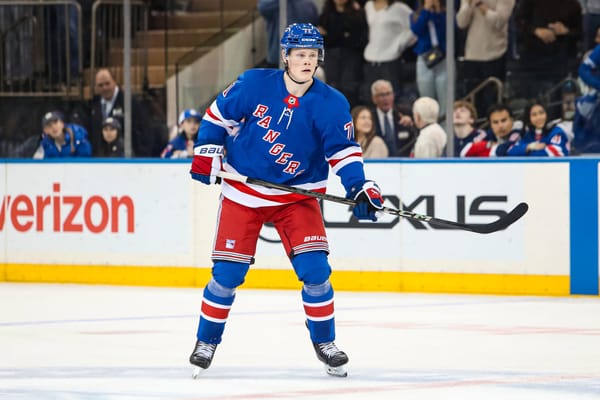Blueshirt Banter 2019 NHL Draft Rankings - #14 Cole Caufield
The diminutive winger has drawn comparisons to Alex DeBrincat. Can he too become a 40-goal scorer in the NHL?
Cole Caufield, US National Team Development Program (USHL)
Vitals
Position: Right Wing
Age on Draft Day: 18.48 Years Old
Height/Weight: 5’7, 163 pounds
2018-2019 Stats (USHL Only): 28 GP, 29 G, 12 A, 23 PIM
Other Rankings
NHL Central Scouting (North America only): 8th
Craig Button: 4th
ISS Hockey: 9th
Hockey Prospect: 11th
Future Considerations: 12th
Elite Prospects: 13th
Scouting Report
In terms of putting together a scouting report, I’m not sure that there are many easier subjects than Cole Caufield. Determining his rightful place in the 2019 NHL Draft and what his future might look like? That’s a hell of a lot more difficult to piece together.
Caufield is a goal scorer. It’s as simple as that. And there are multiple components that make him so deadly.
He is an intelligent player who has an innate ability to know where he must be on the ice at all times in order to receive a pass for a high-quality shooting opportunity. When we think of goal scorers, we tend to think of the shot itself. However, so much of goal scoring happens before the player even obtains the puck. Caufield puts himself in positions to score.
His ability to actually get shots off is impressive. Here is an example of what I mean by that.
This is a hardly a puck positioned in Caufield’s wheelhouse. In the blink of an eye, Caufield was able to transition from awkward puck retrieval into a threatening shooting form. This is, in my view, the most under-appreciated aspect of Caufield’s game. Everyone rightly drools over the shot itself (we’ll get to that), but less spoken of is his ability to shoot the puck in less-than-ideal circumstances. It doesn’t have to put on a tee; if he’s off-balance, or moving against the grain, or in a generally unwieldy body position, he still manages to contort himself into a passable shooting stance.
And yes, his release is absolutely lethal. Aside from Alexander Ovechkin and Patrik Laine, I’m not sure anyone in hockey currently really compares. He’s a nightmare for goaltenders for a few reasons. First, as somewhat alluded to in the previous paragraph, the time it takes for him to get shots off is practically negligible. So much of goaltending is dependent on pre-shot reads, and Caufield doesn’t offer much. His release is so quick, which gives much less time for goaltenders to read his stick and predict where the puck is going, not to mention that they have much less time moving into position and getting square.
The velocity on it is also ridiculous, He can pick corners, sure, but he’s also scored a lot of goals in typically savable locations simply because the puck is an absolute missile in flight.
Add all of these components together and you get a guy who does a whole lot of this, setting a USA single-season record with 72 goals in 64 games.
Caufield’s problem is that as elite as he is as a shooter, he’s equally unspectacular in almost every other aspect of the game.
Listed at 5’7 and 163 pounds, Caufield is small even by today’s relaxed standards. That in itself is not a concern, but the residual effects are. There are some smaller players who are descriptively strong when it comes to practical hockey situations; Sidney Crosby and Mats Zuccarello are two examples. Caufield does not match the description. He does not have a particularly sturdy core and he isn’t going to win puck battles or be hard to knock around.
His skating is a non-asset. It’s not that his feet are bad, and his stride would be perfectly fine on, say, a 6’2 player. Fleet feet and elusiveness is such an important tool for shorter players to make up for what they lack in size. You can’t knock Johnny Gaudreau off the puck if you can’t catch him. Caufield can keep up with the play perfectly well, but he lacks explosiveness or agility that players of his ilk often rely on.
His defensive game is lacking. Size plays its role here, and I don’t think he has the natural instinct to make up for that. Suffice to say that, even with the best possible development, he will not be a player coaches hope to use in defensive situations.
I worry tremendously about his ability to be an actual creator of offense. Caufield is a finisher, but not a starter. He isn’t going to really carry the puck, create zone entries, or establish possession in the offensive zone. He can connect on moderate-level passes but isn’t particularly a playmaker. He’s not someone who will create his own shooting opportunities.
This, more than anything, is the biggest concern. The USNTDP is absolutely loaded with playmakers. Look at the previous video clip of Caufield’s scoring and you’ll see guys like Jack Hughes and Trevor Zegras, among others, feeding him brilliant passes. If not, then here are more examples.
It was a perfect situation for Caufield to get on the scoreboard, but how will this translate long-term? Can Caufield score with similar voracity once the deck is no longer stacked in his favor? What happens if his linemates are merely good rather than otherworldly? When he does play against NHL teams, which are not only faster and stronger but also so well structured tactically?
To be fair, he did look a bit better in this regard at the U18s, but hardly enough to erase these concerns. His work ethic is also commendable. For all of his flaws, no coach is going to accuse him of coasting, playing selfishly, or refusing to take care of his responsibilities.
Take away Caufield’s scoring ability and you have a player who wouldn’t come close to registering on the radar of NHL scouts. But that reminds me of former D.C. mayor Marion Barry, who once infamously said, “Outside of the killings, D.C. has one of the lowest crime rates in the country.”
The objective of a hockey game is to outscore the opposition. Putting the puck into the net is very hard to do. Cole Caufield is extremely good at doing it.
On the other hand, Evan Oppenheimer raised an interesting question during the season; how many pure snipers at the junior level have had NHL success? I initially set out to prove his implied hypothesis wrong, but I discovered those players don’t have a great track record. The only real match I could find was Mike Hoffman.
The list of those who didn’t make the cut is highly populated. Gilbert Brule, Brandon Pirri, Christian Thomas, Reid Boucher, Nigel Dawes are just a few examples of players who generated their fare share of hype as teenagers for their scoring prowess but could get over the hump at the NHL level. It turns out that scoring in the NHL is a lot harder, and coaches don’t have much patience for players who don’t contribute much when they’re not being set up for shooting opportunities.
More recently, Eeli Tolvanen and Kieffer Bellows are more recent examples of prospects whose fates are still up in the air but have seen their stocks plummet as they’ve turned pro.
Caufield is the boom-or-bust player in this year’s draft. The ironic part of my ranking Caufield 14th is that this will almost certainly look horrible with hindsight. Whichever team drafts Caufield is probably ending up with an all-star or a minor leaguer; it’s hard to imagine him carving out a career as a third-liner who scores 17 goals. If he’s a 30-40 goal scorer, then he should have been a top-five pick. If not, then he’s probably not in the NHL at all and 14 will look like a massive reach.
Thus, this ranking is a weighting of the upside versus the bust potential as well as the other players in the draft. I’m clearly far more pessimistic about Caufield than the consensus. I don’t think his upside overcomes the uncertainty compared to the other 13 players on the board, who are themselves very talented. In the early-to-mid teens, though, he’s well worth going for the grand slam. Players who can score 30, or 40, or even 50 goals are so difficult to find. Caufield provides such hope.
What The Others Said
“When he catches a puck, it lays flat. Every pass or shot explodes off his stick. It’s not the flashy dangles, it’s pure, it’s clean.”
USNTDP Head Coach John Wroblewski, via The Athletic
“He can score from anywhere. You put him with any good, first-line forward and he’ll do his job.”
USNTDP Teammate Marshal Warren, via the Detroit Free Press
“I haven’t seen a player in this class with Caufield’s sense of offensive timing, and his ability to get lost in the offensive zone before making himself available for a high-percentage chance is impressive.”
Chris Peters, ESPN




